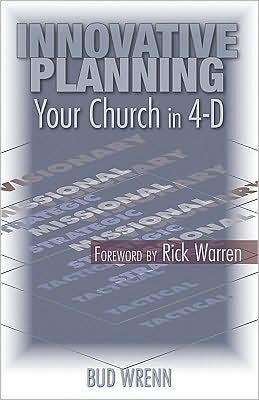Bud Wrenn, Innovative Planning: Your Church in 4-D. Chalice Press, 2008.
Referenced in: Church Leadership Foundations, Church Dynamics, Research
LifeandLeadership.com Summary
This is probably the best “Planning 101” volume available, and should be first reading for anyone thinking about engaging their congregation in intentional strategic development. It is not necessarily a step-by-step process, but is more like a “primer” that describes the components of good planning from a seasoned and successful church leader.
The opening chapters point out two main difficulties ministers have with planning. First, most have difficulty distinguishing between pastoring and planning. Second, when ministers do become serious about planning, they follow inadequate approaches. These include:
- Maintenance planning, tweaking the status quo
- The “Big Blob,” failing to understand the unique, sequential dimensions of the process
- The “Once-and-for-All,” seeing planning as a one-time event rather than continuous, systematic process
- The “Mix-and-Match,” piecing together disparate elements out of a lack of clarity regarding the process
- The “Open Invitation,” trying to involve everyone with little understanding of how each piece of feedback and participation fits into the larger process.
Next, the author describes the characteristics of innovative congregations that can plan effectively and actually benefit from it. The chief distinction is between a slow and cumbersome bureaucratic “freighter” that is preoccupied with procedures, policies, rules, behavioral expectations, etc., over against a leaner decision-making infrastructure characterized by adaptability, maneuverability, responsiveness and speed. But innovative congregations must pay attention to developing this infrastructure, planning from the inside out. To do less is little more than congregational cosmetic surgery that may change the style of music or dress but do little to transform the congregation for the long run.
In the quest to change from the inside out, congregational leaders must give attention to four dimensions of congregational planning (thus Your Church in 4-D as the title suggests). These are developed in Part Two, and include visionary planning, missional planning, strategic planning, and tactical planning. These chapters present one of the most effective definitions of these concepts one can find. For example, they show why vision is not mission and mission and not strategy, etc., but how each of these relates systemically to the others. They discuss how strategies must be aligned with mission and have a strategic synergy among all the activities of the congregation.
Part Four discuss how to make the process work, describing at what level the leaders and members should be involved, and how to get started. Part Four addresses how to sustain the momentum that is begun by good planning.
This is an excellent interpretive guide through the maze of congregational planning. And while it is not a strict step-by-step manual, it gives needed perspective on how other resources in church leadership and management may be utilized most productively.
I recommend this as part of a three-piece prequel to the planning process, alongside Sarah Drummond’s Holy Clarity, and Israel Galindo’s The Hidden Lives of Congregations. Planning, in some form and at some level, is necessary work, but it is also complex work. To do it well, and to experience lasting transformation from the ongoing process, one must know why planning is important with Holy Clarity, understand the nature of congregational systems with The Hidden Lives, and integrate all the pieces of the planning process with Innovative Planning.
From the Publisher
For leaders of small organizations-churches and businesses-who do not have a regular, ongoing planning process, this book will be your guide to becoming an innovative planner for your group’s future.
Innovative Planning presents a solid process for developing complete organizational planning-from vision, to mission, to strategies. It also includes the day-to-day operations-the level at which the vision ultimately comes to fruition.
Experienced pastor and certified leadership coach and consultant Bud Wrenn draws on his organizational experiences to help leaders become “four-dimensional” planners. Not everyone in your group, church, or organization think in visionary terms. But as an organizational leader, it is crucial for you to communicate the vissionary message.
About the Author
Bud Wrenn is the founding director of the Innovative Church Community, which is committed to providing a practical forum for learning and networking for pastors of innovative North Carolina churches, in order to equip them and their churches to reach new levels of excellence. He is also the founding pastor of Integrity Community Church, an eleven-year-old Purpose-Driven church in Burlington, N.C., that has grown from a core of 10 to 750 people.
***For additional information on this resource, including reviews, click the bookstore links. Check the reference at page top or the links below for resource guides on related topics.***
See Other Resources on Church Leadership and Renewal:
- Church Leadership and Renewal, Index
- Church Leadership, Theological Foundations, Ecclesiology
- Church Leadership, Philosophical Foundations – e.g. Church Growth, Missional, Emergent, and Other Missionally Responsive Trajectories
- Church Leadership, Practical Foundations – Church Dynamics and Research
- Church Leadership, Practical Foundations – Congregational Culture, Church Identity
- Church Leadership, Practical Foundations – Size Dynamics, Size Transitions
- Church Leadership, Practical Foundations – Research and Case Studies on Effective Churches
- Church Leadership, Special Situations – Small Church Development
- Church Leadership, Strategies for Renewal
See Resources on Over 100 Areas of Ministry Leadership:


